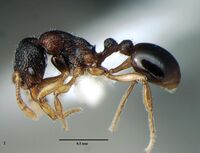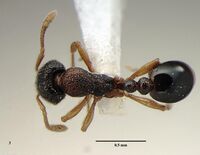Lordomyrma mewasinghi
| Lordomyrma mewasinghi | |
|---|---|

| |
| Scientific classification | |
| Kingdom: | Animalia |
| Phylum: | Arthropoda |
| Class: | Insecta |
| Order: | Hymenoptera |
| Family: | Formicidae |
| Subfamily: | Myrmicinae |
| Tribe: | Crematogastrini |
| Genus: | Lordomyrma |
| Species: | L. mewasinghi |
| Binomial name | |
| Lordomyrma mewasinghi Dhadwal & Bharti, 2023 | |
The type specimens of this species were collected from Pampadum Shola National Park and Karian Shola National Park, India, by Winkler extraction. These parks are located between elevations of 600 m to 1800 m with a daily temperature of 35C and have a dense canopy and leaf litter.
Identification
Lordomyrma mewasinghi shows resemblance to Lordomyrma bhutanensis and Lordomyrma nima. However, it can be distinguished from L. nima based on the following combination of characters:
- pronotum reticulate rugose (longitudinally rugose in L. nima)
- metanotal suture weakly impressed (strongly impressed in L. nima)
- petiole and postpetiole densely punctate laterally (laterally transversely rugose in L. nima)
- dorsum smooth except for few scattered punctures (reticulate rugose in L. nima)
- smooth mandibles (longitudinally striated in L. nima)
Lordomyrma mewasinghi differs from Lordomyrma bhutanensis by the following characteristics:
- petiolar node is thick, generally trapezoidal, and narrowed dorsally, with a roundly convex dorsum (broadly triangular, longer than the anterior peduncle, the anterior border is almost straightin L. bhutanensis)
- postpetiolar node with a sharply toothed anteroventral corner (properly angled anteroventral corner in L. bhutanensis)
- mesopleuron obliquely-rugose (reticulate-rugose in L. bhutanensis)
- petiole and postpetiole densely punctate and dorsally smooth with surrounding punctures (finely reticulate-rugose petiole and postpetiole, sides of petiolar node finely obliquely rugose in L. bhutanensis)
- smooth mandibles (striated in L. bhutanensis)
Lordomyrma bhutanensis is densely decumbent or subdecumbent hairs are present on the body. In contrast, L. mewasinghi is less pilose and pubescent compared to both the above-mentioned allied species.
Keys including this Species
Distribution
Latitudinal Distribution Pattern
Latitudinal Range: 10.1° to 01.1°.
| North Temperate |
North Subtropical |
Tropical | South Subtropical |
South Temperate |
- Source: Dhadwal & Bharti, 2023
Distribution based on Regional Taxon Lists
Oriental Region: India (type locality).
Distribution based on AntMaps
Distribution based on AntWeb specimens
Check data from AntWeb
Countries Occupied
| Number of countries occupied by this species based on AntWiki Regional Taxon Lists. In general, fewer countries occupied indicates a narrower range, while more countries indicates a more widespread species. |

|
Estimated Abundance
| Relative abundance based on number of AntMaps records per species (this species within the purple bar). Fewer records (to the left) indicates a less abundant/encountered species while more records (to the right) indicates more abundant/encountered species. |

|
Biology
Castes
Nomenclature
The following information is derived from Barry Bolton's Online Catalogue of the Ants of the World.
- mewasinghi. Lordomyrma mewasinghi Dhadwal & Bharti, 2023: 2, figs. 1-3 (w.) INDIA (Kerala).
Unless otherwise noted the text for the remainder of this section is reported from the publication that includes the original description.
Description
Worker
Holotype: TL 1.74, HL 0.76, HW 0.64, CI 84.21, SL 0.50, SI 78.12, ED 0.10, PW 0.44 , WL 0.88, PL 0.34, PH 0.22, DPW 0.20, PPL 0.20, PPH 0.22, PPW 0.26, PPI 110. Paratype: TL1.72-1.78, HL 0.72-0.77, HW 0.62-0.66, CI 86.11-85.71 , SL 0.48-0.58, SI 77.41-87.87 , ED 0.10-0.13, PW 0.44-0.48 , WL 0.84-0.90, PL 0.34-0.38, PH 0.20-0.22, DPW 0.22-0.26, PI , PPL 0.20-0.22, PPH 0.22-0.24, PPW 0.22-0.26, PPI 110-118 (9).
In full view, the head is longer than broad. The head is wide posteriorly and narrows in the front. In the middle, the posterior edge is slightly concave. The lateral margins are convex. Occipital corners are rounded. Mandibles elongate, triangular with 7 teeth.
In profile view, promesonotum fairly convex. Mesometanotum suture weakly impressed. The propodeal dorsum not straight, generating downward sloping curve. Propodeal declivity concave, and propodeal lobes triangular and longer than propodeal spine. Petiolar node convex dorsally. Petiolar node is thick and trapezoidal with roundly convex dorsum; the anterior peduncle significantly shorter than length of node, with small ridge extending from anteroventral corner. Postpetiolar node with roundly convex dorsum with nearly straight ventral edge, and sharply toothed anteroventral corner.
In dorsal view, pronotum wider than remainder of mesosoma, lateral margins strongly convex, humeral corners rounded. Promesonotal suture absent. Mesonotum narrowest, lateral margins slightly convex. Metanotal groove weakly impressed. Propodeum widened posteriorly, lateral margins almost straight. Anterior peduncle of petiole widened posteriorly, petiolar node roughly rounded, as broad as long. Postpetiole widened posteriorly, lateral margins moderately convex, broader than petiole node.
Mandibles smooth. Cephalic dorsum with dense posteriorly divergent rugae, rugae becoming reticulate-rugose laterally. Clypeus relatively smooth and shining. Mesosoma reticulate rugose; sides of pronotum reticulate rugose; mesopleura obliquely-rugose; propodeal dorsum and declivity transversely rugose, propodeal sides transversely rugose. Petiole and postpetiole densely punctate laterally, dorsum smooth except for few scattered punctures. Gaster smooth and shining.
Body dorsum with few erect to suberect hairs, pubescence sparse, hairs on cephalic dorsum short and dense. Antennal scapes with dense subdecumbent hairs and decumbent pubescence, tibiae with dense decumbent pubescence.
Body-color blackish brown; mandibles, antennae, and legs reddish-brown.
Type Material
- Holotype worker: India, Kerala, Pampadum shola National Park, 10.12660N, 77.25820E, Winkler extraction, 1300m, 25.i.2017, Tarun Dhadwal leg. [PUAC-T04] (“Punjabi University Patiala Ant Collection” at Department of Zoology and Environmental Sciences, Punjabi University, Patiala, Punjab, India).
- Paratypes: 7 workers with same data as holotype [PUAC]; 2 workers, Kerala, Karian shola National Park, 10.38330N, 77.08330E, Winkler extraction, 650m, 1.ii.2017, Tarun Dhadwal Leg.
Etymology
The species is named in honor of Professor Mewa Singh, who has worked extensively on the behaviour of primates from India.

